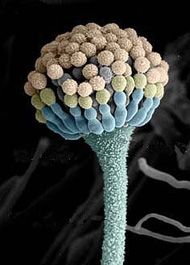Subkingdom: Mycota
Division: Eumycota
Sub-division: Deuteromycotina
- G.C. Ainsworth’s system of classification includes Deuteromycotina which is a subdivision under Eumycota
- It is also known as Fungi Imperfecti as it lacks a perfect or a sexual stage and also asexual fungi, anamorphic fungi, and conidial fungi.
- It has around 17 000 species.
- These are non-motile structures.

General Characteristics
- It is a polyphyletic group where many species are closely related to organisms in other phyla like in Ascomycotina and Basidiomycota and hence it is not a true phylum.
- They might be terrestrial or aquatic.
- In a fungus that has both an ascus (or basidium) stage and a conidial one, the former is known as the ‘perfect’ and the latter as the ‘imperfect’ state. This is why these fungi are commonly called Fungi Imperfecti.
- Also, it may happen that the fungi might have more than one imperfect stage.
- Members of these classes might have septate mycelium.
- The mycelium might be inter or intracellular having many nuclei
- Hyphae might be a heterokaryotic type.
- The reproduction mostly occurs by conidia, however, a few are purely mycelial, developing no spores.
- Sexual reproduction is absent in these members.
Classification
It is divided into 3 classes.
- Blastomycetes- It majorly forms single yeast-like cells from budding.
- Hyphomycetes- This group contains the fungal species which have the potential as microbial insecticides. This has naked conidia.
- Coelomycetes- The fruiting structures might be spherical with an apical opening or saucer-shaped. The production of conidia takes place within the fruiting body.
Reproduction
Reproduction might be vegetative or asexual.
Vegetative Reproduction
It might occur by budding.
Asexual Reproduction
- Conidiospores- Reproduction majorly takes place by spores (conidia) which is produced mitotically (asexually) or by hyphae (conidiophores).
Sexual reproduction
Sexual reproduction is entirely absent in the life cycle of this form of fungus, so its life cycle is incomplete in nature.
Life Cycle

Economical Importance
- The food industry like the cheese industries uses these members for ripening purposes.
- The blue veins in Roquefort cheese and the white crust on Camembert are the results of fungal growth.
- It has also contributed to the discovery of the antibiotic penicillin
- These are a cause of a few diseases in both plants and humans and are also known to be the producers of potentially toxic compounds, like aflatoxins released by fungi Aspergillus.

References
https://www.sciencedirect.com/topics/agricultural-and-biological-sciences/deuteromycotina
https://link.springer.com/chapter/10.1007/978-94-011-1496-7_6
More Topics To Read
